How Dell Got Soul
When growth slowed in Y2K, the computer maker’s leaders realized they needed to redesign their win-at-all-costs culture.
(originally published by Booz & Company)
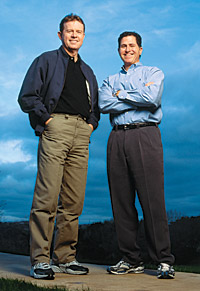 |
|
Photograph by Wyatt McSpadden |
Kevin B. Rollins had been at the company for seven years. Then the senior vice president for strategy, he had come to Dell on a consulting assignment in the midst of another crisis, in October 1993, when the company recalled an entire line of new notebook computers because of design flaws.
As he observed the reactions of employees lamenting as their stock options and dreams went underwater, Mr. Rollins recognized that the new problem was worse.
“I realized that we had created a culture of stock price, a culture of financial performance, and a culture of ‘what’s in it for me?’ throughout our employee base,” says Mr. Rollins, who this year became Dell’s chief executive officer. “There had to be something more in this institution that we loved and enjoyed than just making money or just having a stock price that went up.”
Today, by nearly any measure — market share, return on invested capital, or simple revenue growth — Dell is among the most successful companies created in the last 50 years. This year, its 20th anniversary, the company expects to reach nearly $50 billion in revenues, and to grow more, in dollar terms if not by percentage, than in any previous year in its history.
It’s easy to forget that Dell’s success was not foreordained. Indeed, the company’s resurgence and sustained growth during the past several years owes much to its leaders’ insight that something fundamental — at least as essential as its supply chain, and perhaps even more so — needed to be reformed: Dell’s soul.
As he and other senior managers led the company through two painful rounds of layoffs, which further damaged morale, Mr. Rollins began to examine seriously Dell’s corporate culture — the institutional values and belief systems that influence Dell’s behavior as an organization and the behaviors of each employee. He wondered if these not-easily-understood facets of corporate culture were adversely affecting near-term financial performance, as well as Dell’s long-term health and strength.
Mr. Rollins had been thinking about the role of culture in civil societies and organizations for some time. But the confluence of the market downturn of 2000 and the terrorist attacks of September 11, 2001, prompted him to reflect more intensely about what Dell stood for, and why he was there. He concluded that underpinning traditional business performance benchmarks are new measures for how to succeed in business: Speed, integrity, adaptability, and resilience are becoming the true tests of whether a company is built to last.
How Mr. Rollins, together with company founder Michael S. Dell and other leaders, put Dell back on track makes a powerful case for the role corporate culture plays in enduring business performance. Their story also strongly suggests that, over the long run, the healthiest and wealthiest companies are those that define their strategies and management systems with a purpose beyond merely increasing returns to shareholders.
“What great companies have always done is to find ways to appeal to another side of human nature, wanting to be associated with something that’s great,” says John P. Kotter, an expert in leadership and culture and a retired Harvard Business School professor. “You want to find the nature of what you’re making exciting and believe that this product or service does something useful for humanity. Great companies institutionalize that, and you can’t fake it.
“It’s not just in your business model,” Professor Kotter says. “It’s in people’s hearts.”
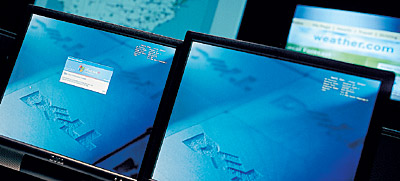 |
|
Photograph by Vern Evans |
Cultural Influences
The notion that corporate culture influences and is a key to understanding business performance is commonly accepted today. However, it was only a bit more than 20 years ago that academics introduced the term corporate culture to the business vocabulary. It is even more recently that practicing executives have started to appreciate its significance.
Corporate culture is still a somewhat squishy way to describe all the things that lie beneath the rational and measurable surface of an organization. But most management theorists agree on some variation of this basic definition: Corporate culture is manifest in distinctive patterns of human behavior based on core values, beliefs, and traditions. Culture is made tangible by corporate lore, ceremonies, celebrations of achievement, and institutional comportment, as well as through a company’s goals, strategies, management processes, structure, and methods of allocating resources.
In the 1980s, seminal writing about culture and business, such as Corporate Cultures: The Rites and Rituals of Corporate Life (Perseus, 1984), by Terrence E. Deal, a professor of education at the University of Southern California, and Allan A. Kennedy, a management consultant based in Boston and London, and Organizational Culture and Leadership (Jossey-Bass, 1985), by Edgar H. Schein, a professor at the MIT Sloan School of Management, posited the then-fresh idea that effective leadership and long-term success were tied to the creation of a healthy corporate culture. Corporate Culture and Performance (Free Press, 1992), by Professor Kotter and his Harvard Business School colleague James L. Heskett, offered the first detailed study of the relationship between a strong, positive corporate culture and superior performance.
More recently, a spate of books have equated overly earnings-driven companies with dysfunctional cultures and declining corporate health, including Professor Deal and Mr. Kennedy’s The New Corporate Cultures: Revitalizing the Workplace after Downsizing, Mergers, and Reengineering (Perseus, 1999); Value Shift: Why Companies Must Merge Social and Financial Imperatives to Achieve Superior Performance (McGraw-Hill, 2003), by Lynn Sharp Paine, of the Harvard Business School; and A Company of Citizens: What the World’s First Democracy Teaches Leaders about Creating Great Organizations (Harvard Business School Press, 2003), by Brook Manville, chief learning officer of Saba Software, and Josiah Ober, professor of classics at Princeton University.
The authors of A Company of Citizens suggest that corporations examine how the uniquely participative system of democracy of the ancient city-state of Athens helped unleash the creativity of the Athenian people and channel it in ways that produced the greatest good for the whole society. Mr. Manville and Professor Ober say that the Athenian system succeeded in bringing individual initiative and a common cause into harmony, which is precisely the synthesis that modern companies need to realize the full power of their people and thrive in the knowledge economy.
Yet even as management scholars draw attention to the linkages between company culture and business performance, they also argue that deliberate culture change — if it is even possible — does not occur because top management commands it to happen through a written statement of values, a high-profile change program, or a combination of initiatives. In The New Corporate Cultures, Professor Deal and Mr. Kennedy absolutely reject the argument that one can successfully modify culture just because top leaders say it must be done. And even when cultures do begin to change, these scholars emphasize that it usually happens in a trying and disorderly way.
“Cultures change only when they need to and are damned well ready to change,” they write. “They change when their collective intelligence recognizes that the world has changed and that the culture better adapt in order for the business to survive.”
Typically, it takes a dramatic shock — an economic crisis, a scandal — to move an organization’s people to be reflective enough to address flaws in the corporate culture, or to strengthen positive attributes. Whatever the circumstances, striving to make deep changes in culture is a difficult and painful process.
Other scholars of organizational behavior share the Deal–Kennedy view. “It’s hard enough to train a dog, let alone a human being, let alone an organization, to behave in a certain way,” says James O’Toole, a research professor in the Center for Effective Organizations at the University of Southern California, himself an author of dozens of books on leadership and culture change. “It’s hard to do because you’re asking people to look at themselves and be able to accurately understand what they value and how they’re behaving. You can say, ‘We want the following 10 behaviors and we’re going to reward them.’ You can measure the extent to which people are doing that and reward them. But you can’t see the values, and the values are the hidden part of the culture that drives the behavior.”
Professor Kotter is likewise wary of the formulaic guides of countless culture change experts. “Almost all programs I’ve seen labeled ‘culture change’ have failed because you don’t change culture by going at it directly. You get people to change how they do things: behavior, practices, and organization. And if you succeed in finding a new way of operating, it kind of seeps into and becomes the new culture. It’s an indirect effect.”
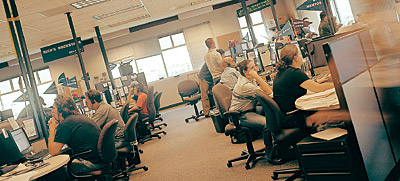 |
|
Photograph by Vern Evans |
Close Reading
The indirect culture change effect is often kicked off by an introspective and influential leader, such as Kevin Rollins.
After his consulting stint in the early 1990s, Mr. Rollins joined Dell full time in 1996 as senior vice president for strategy; he became its president in 2001, and this year he succeeded Mr. Dell as CEO. (Mr. Dell remains chairman.) The two have led the company virtually side by side, and continue to share an office space separated only by a famously always-open sliding glass partition.
Mr. Rollins was not a newcomer to the notion that companies are made or broken by their values. In 1997, he had even articulated the concept in a speech to employees, which he titled “The Soul of Dell.”
He says his journey as a change leader at Dell began, in part, through a close reading of certain books. He cites the work of Mr. Manville and Professor Ober as highly influential in his thinking, specifically their notion of employees as citizens in a meritocracy. He read a number of other management tomes as well, but says he was most inspired by a far different collection of books. It began with a reading of Joseph J. Ellis’s Founding Brothers: The Revolutionary Generation (Alfred A. Knopf, 2000), a highly personalized study of the intertwined lives of the founders of the American republic — John Adams, Aaron Burr, Benjamin Franklin, Alexander Hamilton, Thomas Jefferson, James Madison, and George Washington. Soon Mr. Rollins was devouring books about the Founding Fathers and the early days of the republic.
“I went on a journey to read every book about the Founding Fathers,” Mr. Rollins says. “I found that their whole mind-set of what they were thinking and doing to create the country fit with what I was thinking and wanted to do with Dell’s culture. It was very idealistic. These guys were very selfless, doing it out of a tremendous intellectual interest in doing what they felt had to be done. And they did it at great personal sacrifice. All of them could have been wealthy. They had a vision of creating something that had not been created before, better than anything before, and they believed it to their bones. I found that massively inspirational,” he says.
Mr. Rollins found many parallels between the creation of a new nation and the change process in a young company, including a similar selflessness in Dell’s senior management team, which appealed to him. “We have always been trying to create something we haven’t seen in other corporate models,” he says. “We are iconoclastic. We know our model is different.”
But as he examined Dell’s culture, the only corporate value Mr. Rollins could clearly identify was its drive toward a “culture of winning.”
Mr. Rollins says, “So I thought, Why not put some detail around our culture? We know our model to a gnat’s eyebrow. But we didn’t know our culture, except superficially.”
In an interview earlier this year, Mr. Dell described this time in Dell’s history as a period of “soul searching.” “We had this incredible boom in the ’90s, and a lot of people had made a lot of money, which in some ways hides a lot of problems,” he said. “The dark side of the boom we pondered was the possibility that we had attracted a lot of people who thought they would get rich. And, if they all of a sudden thought they wouldn’t get rich, then they’d wonder what they’re doing here.”
To help get beneath the surface of Dell’s culture, and to learn more about the breadth of its values, Mr. Rollins turned to Paul McKinnon, an old friend and former academic specializing in organizational behavior, whom he had recruited in 1997 to head human resources. From the start, they understood the goal was not to create a new or different culture for Dell, but to adapt and enhance its positive elements.
“It’s not that we didn’t have a culture with the qualities that drive business success: We were performance-driven, cost-driven, built on speed, very low on politics,” recalls Mr. McKinnon. “We just aspired to do better. Kevin started to revisit those old questions: What kind of company do we want to be? What is our aspiration? What would a new winning culture look like here at Dell?”
Of this line of questioning, the godfather of corporate culture, MIT’s Ed Schein, observes that Dell’s experience had more to do with maturation than with cultural change. “The question about Dell is, Was culture involved at all?” Professor Schein asks. “Changing ‘purpose’ or ‘goals’ does not necessarily involve culture. In fact, it may be the Dell culture itself that enabled the company to make the changes it has made in how
it operates.”
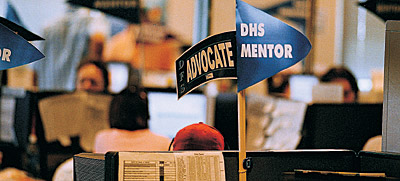 |
|
Photograph by Vern Evans |
Slowing Growth
Whatever one labels its journey, Dell had an advantage over other companies that have embarked on similar efforts to understand and change their institutional behavior. Whereas a performance crisis is often the wake-up call that forces a company to attempt bold change, in 2000 Dell had not experienced a catastrophe. Although not achieving all of its business plan goals, the company was still more profitable than its major competitors, including Compaq, Hewlett-Packard, Sun Microsystems, and the relevant portions of IBM. Moreover, it gained market share in 2000 and 2001. Still, the slowing of Dell’s historically rapid growth rate allowed the company the opportunity to step back and reflect on what its culture represented and what it really wanted to be.
In contrast to large industrial-age companies that struggle to adapt to the demands of today’s competitive environment, Dell was naturally lean, fast, and entrepreneurial. These were the desired attributes of a large high-performance company in a high-speed and unpredictable business world. This spared Dell the pain and disruption of a major downsizing and restructuring as it dealt with change in its corporate culture.
These qualities are also exemplified in the behavior of the company’s founder. At 38, Mr. Dell is still a young man; in person, his affable and informal manner makes him seem younger yet, and more approachable than other leaders of multibillion-dollar concerns. Leading by example, he shows how much he personally values collaborative management and communication styles. Mr. Dell has historically shared the executive suite with a strong second-in-command. Before Mr. Rollins, there was Mort Topfer, who applied his experience building Motorola’s cell phone business to help refine Dell’s direct sales model in the 1990s; and before Mr. Topfer, Lee Walker, an East Coast entrepreneur, helped run Dell and take the company public in 1988.
Even after two decades, Dell has retained its informality and the energy to execute like a startup company. Dell is a prototypical flat organization. From the factory floor to corporate communications, decisions are made quickly and without the burden of superfluous hierarchy. If a supervisor on the factory floor sees ways to reduce component inventories, he simply does it, without going up the chain of command for approval. Dell’s internal communications have stayed efficient, so that decisions that don’t require the attention of senior management get made without them.
In April 2001, “when one of our major competitors announced they had missed their quarter at 4 p.m., by 2 a.m. the next morning we had a press release out that we were going to cut prices,” says Lynn Tyson, Dell’s vice president for investor relations. “Kevin and Michael said this is an opportunity, and Dell executed. That could not have happened with bureaucracy in the middle.”
The accessibility of management, from Mr. Dell on down, has made junior employees believe their ideas are welcome and heard. “You have freedom of communication to anybody,” says Matt Borgstrand, a product engineer in the enterprise computing group. Mr. Borgstrand designed a software diagnostic tool now used throughout the company, even though writing software is not part of his job. “There’s an openness here. I had an idea, walked into a vice president’s office, and he said, ‘Go do it.’ I didn’t have to go through layers of management,” he says.
Mr. Dell and other executives also insist that Dell’s direct “build-to-order” business model — bringing technology-rich products to market at a lower cost by eliminating the middleman and reducing costly stockpiles of inventory — benefits humanity by making those innovations more broadly affordable.
Finally, Dell is a company that does its best to make people feel comfortable expressing true feelings without fear, and with confidence that if they do speak their minds, they can make a positive difference for themselves and the company. For example, an anonymous, voluntary employee feedback survey that’s conducted online every quarter, called “Tell Dell,” encourages rank-and-file employees to let senior management know how they feel about the company and about specific leaders, and to flag problems in a nonconfrontational way. The HR department compiles results, and specific leadership teams share those results with managers throughout the company. Leaders of different departments set improvement goals for their teams. Every manager’s appraisal is based on improvements he or she makes on Tell Dell scores against the goal set for his or her team.
Tell Dell has also been integral to involving everyone in the company in the culture change process, and to measuring progress. Ninety percent of Dell’s global work force participated in the most recent Tell Dell survey.
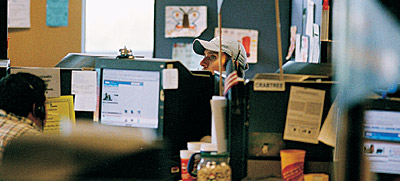 |
|
Photograph by Vern Evans |
Baring Its Soul
Dell’s core values — which include its drive to win, its direct business model, and the sense that there are many more opportunities for Dell to do well for financial and societal stakeholders — were codified in an official statement of values published in 2002 and named, not surprisingly, “The Soul of Dell.” (See “Focus: Dell’s Core Values Statement,” below.) It is the centerpiece for managing, measuring, and reinforcing the cultural elements Dell believes are its source of business success.
|
Focus: Dell’s Core Values Statement |
|
The Soul of Dell Since its beginnings, our company has been guided by the value of building direct relationships as well as other operating values that have led us to become one of the world’s most admired companies. The Soul of Dell is our statement of corporate philosophy. It provides a common statement of our basic values and beliefs and serves as a guide for our company in the many cultures we call home. Our values and beliefs communicate the kind of company we are and aspire to be. This document is intended to assure that our actions — worldwide — are consistent and supportive of our values and beliefs. At Dell we value and are committed to Customers, The Dell Team, Direct Relationships, Global Citizenship and Winning. Customers We are committed to:
The Dell Team We are committed to:
Direct Relationships We are committed to:
Global Citizenship We are committed to:
Winning We are committed to:
Source: Dell Inc. |
“The Soul of Dell” is made up of five elements: customer loyalty, teamwork, direct communication and relationships, global citizenship, and winning.
Clearly, simply creating a values statement and hanging it on walls is not enough. It not only needs to be visible; it needs to be a management tool. The Johnson & Johnson “Credo” has been cited for decades for helping its company leaders and employees at all levels make the right decisions, in good and bad times. The inspiration of Johnson & Johnson’s founder, Robert Wood Johnson, the Credo is part of the “genetic code” that informs the company’s structure, its information flows, its incentive systems, and the distribution of decision rights. Other well-known examples of highly credible and actively used values statements include those of the U.S.-based global utility company the AES Corporation and the “values vision” of apparel maker Levi Strauss & Company.
“The Soul of Dell” was written to make Dell’s corporate values explicit, and to address the immediate business problem that senior management acknowledged in 2000. It helped impose discipline during the unruly early stages of corporate change.
“Now when people ask, ‘If I’m not going to be rich, why would I want to stay?’ the document allows us to answer those sorts of questions,” says Mr. McKinnon. “It says this is the kind of place we want to be.” In the tradition of J&J, AES, and Levi Strauss, “The Soul of Dell” is also used as a guide to continuous improvement of management practices as the company matures and embarks on more change and adaptation.
In keeping with Dell’s nonhierarchical approach to management, creation of “The Soul of Dell” combined top-down and bottom-up input and action planning. In late 2001, the company had a series of worldwide meetings at the vice president level (in person and by videoconference) to gain broad perspective and polish the document. Dell engaged an outside firm to perform a “cultural audit,” a common questionnaire-based process, to identify strengths and weaknesses throughout the company. The audit showed Dell’s strong push for winning and operational excellence, but exposed weaknesses in the areas of career development and work/life balance.
In codifying what the culture represented and examining the conflicts in “real life” at Dell through the cultural audit, “pretty frank” feedback began to surface, recalls Michael George, Dell’s chief marketing officer and vice president.
“There are two or three fair criticisms we could make of ourselves,” Mr. George says. “One is we have folks who get great business results, but they break too much glass along the way. They’re not collaborative with their colleagues. We probably tolerated that too much.” The audit also showed that the company was not investing enough in personal development and career guidance resources. Dell’s rapid growth and relentless focus on gaining market share had created a culture in which making the numbers often came at the expense of teamwork and customer satisfaction. And surveys showed that certain sales leaders were routinely rewarded and promoted despite trampling on the feelings of their team members. New hires complained that they had been thrown into the most challenging position of their lives with little support or backup from superiors.
“We saw there was a little too much of a sink-or-swim mentality,” says Mr. George.
These negative aspects of Dell’s culture had remained submerged as long as Dell’s financial performance and share price appreciation had offered the promise of great wealth. But employee concerns came to the fore when growth slowed. To their chagrin, Mr. Dell and Mr. Rollins also learned from a Tell Dell survey that about half of Dell’s employees would leave for another company if they were given similar compensation.
Even some top performers said the relentless pressure had wearied them. “I know that for me, the only thing that mattered was making my numbers, but I also knew that shaking the money tree was going to get old,” says Amy Rathburn, a major-accounts manager for school districts in the greater Austin, Tex., area. “My passion is really the kids, sitting down on the floor with the third graders with their laptops. ‘The Soul of Dell’ gave me the space to figure that out, so it’s not always just selling, selling, selling.” Today, although sales growth is as vital as ever, living “The Soul of Dell” means sales are not the only thing that is important to business performance.
One seemingly symbolic act that helped to reinforce the importance of “The Soul of Dell” was that members of senior management began sharing the findings of their own appraisals with their direct reports. That practice has now spread to every level of the company.
“It started from where it always starts, with Michael and Kevin,” says Mr. McKinnon. “At that original vice presidents’ meeting, they both got up and talked about their own 360s: ‘Here’s what I learned about myself.’ Michael, in particular, at that moment, said, ‘I’ve got some things to work on. I’m not done yet. I want to get better.’ That attitude of ‘We’re all working on something important here’ permeated everybody in that room.”
Particularly in a company that is still led by its founder, setting values by personal behavior is critical, says Richard Hagberg, a consulting psychologist and organizational consultant based in San Mateo, Calif. He says leadership and culture are flip sides of the same coin. As companies grow larger, they become less leadercentric in general. The exceptions are companies with larger-than-life founders. “There the shift needs to be toward a more values-oriented culture, so it’s not about the leader, it’s about the vision and the values,” says Dr. Hagberg.
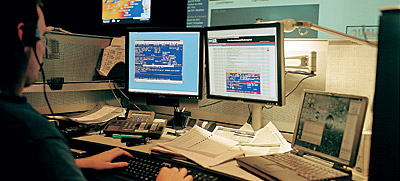 |
|
Photograph by Vern Evans |
Measurement Culture
At first glance, “The Soul of Dell” reads like a list of fairly standard corporate verities. But there are detailed commitments in each section that are company-specific and measurable. Improvement on each of these measures is a closely watched part of managers’ performance reviews, promotions, and compensation.
Mr. Dell says those measures were critical in making the aspirations articulated in “The Soul of Dell” into a reality. “We’re a very analytical, metrics-based, show-me-the-numbers kind of company,” he says. “This was soft, touchy-feely stuff, so we had to put measurements in place to monitor our progress against a series of actions.”
In performance reviews, Dell holds people accountable for acting according to the standards codified in “The Soul of Dell.” For instance, Dell management has made very explicit that half of employees’ ratings for the year is based on what they achieve financially — growing a business, hitting or beating sales targets — and half is based on how they do it, as revealed in the 360-degree appraisal. This year, says marketing chief Mr. George, managers had some “quite painful discussions with people who received the highest rating for meeting plan performance but got a low rating for the way they got there, which reduced their net score.” He also notes that some of this year’s Tell Dell scores for managers actually went down. “But that’s understandable; we’re changing and it’s stressful,” he says.
Such stress points to one of the challenges Dell continues to face: maintaining awareness of and responsiveness to the core values in “The Soul of Dell,” even as financial results improve.
“If you start with values, and you do everything Dell is doing — measure it, tie it to compensation, and so forth — the chances of cultural change taking hold and making a difference are pretty good,” says William Schneider, president of the Corporate Development Group, a Denver-based consultancy, and author of The Reengineering Alternative: A Plan for Making Your Current Culture Work (McGraw-Hill, 1994). “The key is to stay the course, and for leaders to consistently reinforce what they’re trying to do, so that everyone who works for the company is clear this is not a passing fad sold to senior management by a consultant. A lot of people look for quick results: ‘Are we done? Let’s hurry up.’ But values are perpetual — they never go away — and they need to be treated that way. Articulating the values is important, but after they’re articulated, it’s all about the long term.”
Although employees have been known to use it for venting frustrations over minor irritations, Tell Dell continues to be a powerful mechanism to keep the discussion about values going. Indeed, Mr. Rollins still sees Tell Dell as part of the enfranchisement process that Mr. Manville and Professor Ober identify in A Company of Citizens, in which employees take ownership of ethical and governance issues rather than waiting for leaders to act.
Although Dell has been free of the scandals that have plagued other high-profile companies in recent years, those events were very much on Mr. Rollins’s mind when he laid out his agenda for culture change back in 2001, and they continue to guide the leadership of Dell.
“We want a culture that says democracy should rule out the evil,” Mr. Rollins says. “When you see people not behaving responsibly, people not being honest in everything they do, you tell them about it, and don’t let them ruin the company. We want to put the ownership of compliance on every single employee. We’ve told our people if you don’t say anything, then you are to blame. And we can’t fix a situation we don’t know about.
“Our promise to you is, if you tell us, we’ll treat you fairly, and we’ll fix it,” Mr. Rollins says. “Certainly every person who blows a whistle doesn’t find something wrong. We have people who call our hotline when they’ve had a fight with their manager. Well, that’s not fraud, but I’d rather have 100 of those than one person who doesn’t call because they think we won’t do anything about it.”
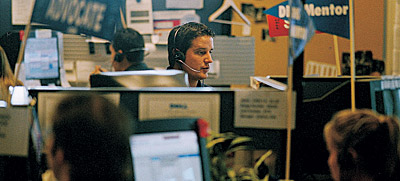 |
|
Photograph by Vern Evans |
Intangible Value
Dell operates in an unforgiving business environment, but the company remains determined to outgrow competitors and dominate in all its markets. Dell met its revenue and earnings forecasts for the quarter ending April 30, 2001, and has met or exceeded analysts’ estimates in every quarter since. In the third quarter of fiscal 2004, quarterly income rose a healthy 22 percent, with the record growth in sales that Dell depends on.
Analysts in the third quarter closely questioned the company’s rising inventory levels and higher costs for the dynamic random access memory chips it uses in its computers, which imposed an additional $10 per computer, which Dell could not pass on to the consumer without hurting sales. The average price for Dell PCs actually dropped by $50 from a year earlier, in response to more aggressive pricing by Hewlett-Packard. Simultaneously, Dell moved into third place for the first time in worldwide market share for corporate servers, according to Gartner DataQuest. Hewlett-Packard and IBM remain the leaders worldwide in this intensely competitive market, but Dell is, for now, neck and neck with Sun Microsystems.
No one is suggesting that Dell’s continuing resilience or its return to its historic performance levels from 2000 was in any way contingent on creating “The Soul of Dell.” Dell probably would have made its numbers with or without examining its soul. Senior management never discussed this effort with Wall Street.
Nevertheless, securities analysts who closely follow the company say its commitment to improving how it does business has made a major source of intangible value visible in ways that impress them. “Dell remains so constant on the outside in its personality that there would have to be something that is feeding that constancy and refreshing it,” says Laura Conigliaro, an analyst with Goldman Sachs, which has also served as Dell’s investment bank. “We’re always amazed by how Dell’s persona remains so methodical and in touch. From anywhere in the world at virtually any time, send an e-mail to somebody and you don’t have to count the minutes until you get a return. That might seem simple, but it’s so different from what we experience elsewhere. I have the sense that anything this company puts a great deal of effort into has to have some backbone to it, and not just be an exercise in corporate solidarity. They understand and appreciate that as companies get really large and you start to add new generations of employees who are more withdrawn from the top of the company and history, it becomes more important to have mechanisms to spread the culture.”
Indeed, the most important role of “The Soul of Dell” may be to evangelize new hires who never will ride an elevator with Mr. Dell or Mr. Rollins. Dell is again in a hypergrowth phase and hiring vast numbers of men and women. Although some long-term employees say nothing has changed for them personally, they still see a value in formally codifying the Dell culture, and infusing the values in the design of management systems.
“As new people come on board, there’s certainly a large part of the population that’s jaded and has a negative [impression] about working for corporations,” says Paul Wicker, a computer programmer on one of the maintenance teams that support Dell’s sales applications. “The Soul of Dell” lets people know “Dell is a meritocracy. If you work hard and do a good job, you get rewarded for it. It also says that just getting the job done is not as important as how you do it, and the quality of the teamwork you do it with.”
Although cultural change yields tangible results only over time, Dell has been able to track some immediate and meaningful improvements, as identified in the quarterly Tell Dell surveys. Employees say management is more inclined to support their efforts to achieve better work/life balance. Workers also see a clearer link between their jobs and Dell’s corporate objectives. The percentage of people who would stay at Dell given a comparable offer elsewhere has risen, although at 57 percent, it is still not as high as management would like.
Has Dell changed its culture in any fundamental way? Maybe not. But it has clearly harnessed those positive aspects of the culture that allowed it to come so far so fast.
At 20, Dell still feels like a “scrappy startup company,” Mr. Dell says. But he won’t be taking too much time to admire and relish the company’s vigor or accomplishments. “Let’s get better. I’m 38 years old now. I want to look back in 40 years and be proud.”![]()
Reprint No. 04305
Lawrence M. Fisher (fisher_larry@bah.com), a contributing editor to strategy+business, covered technology for the New York Times for 15 years and has written for dozens of other business publications. Mr. Fisher is based in San Francisco.


